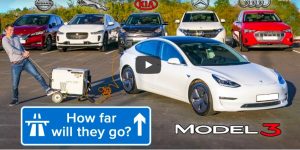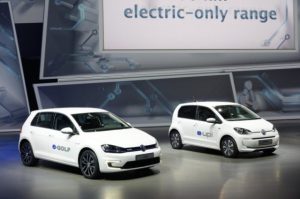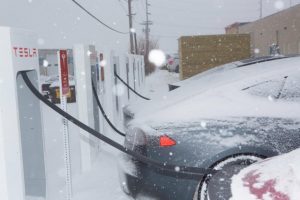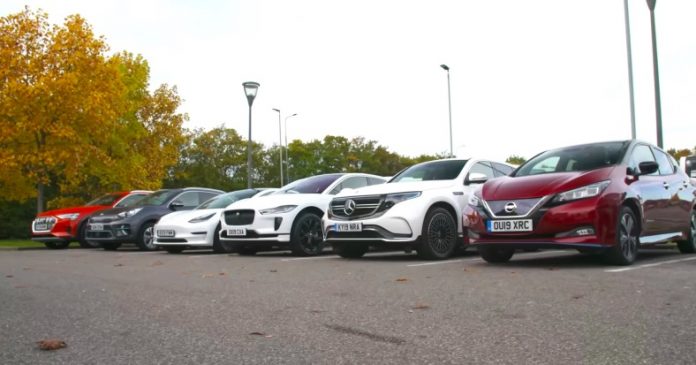Volkswagen got fined billions – and its executives and engineers were criminally prosecuted – for “cheating” on government emissions certification tests that involved differences of much less than 1 percent. Why is it that electric cars are allowed to cheat the public by double digits when it comes to what they claim about their range on a full charge vs. what they actually deliver?
As a car journalist – someone who regularly test drives new cars, including electric cars – I have known for some time that the range delivered by EVs in real-world driving is always much less than advertised.
About 15-20 percent less.
Other car journalists – at Jalopnik, which is owned by the SJW media conglomerate Huffington Post and so presumably not “anti-EV” – recently confirmed this.
They did a same-day/same-conditions real-world road test of six-brand new EVs and found them lacking. Not one of them came close to delivering on their promised maximum range, including the sainted Tesla Model 3.
Five of them went about 20-25 percent less-far than advertised, indicating it’s not a problem with one specific EV or the way that particular EV was driven.
It’s a general problem – and the same government that practically nailed VW to a cross over almost unmeasurable differences in exhaust emissions that would never have been noticed – certainly not by VW owners – had it not been for an inquisition worthy of Torquemada determined to find something – anything – is interestingly indifferent to this very noticeable cheating.
We’ll get to the motivation for that shortly.
Meanwhile, these scandalous disparities between what’s touted and what’s delivered – according to Jalopnik:
The $69,850 to start Jaguar iPACE (Jaguar’s first electric car) travelled 25 percent less-far-than-advertised.
The $68,895 Mercedes’ EQC 400 (Mercedes’ first all-electrioc car) went 24 percent less-far-than-advertised.
The Audi eTron delivered 19 percent less-than-advertised range.
And the sainted Tesla 3? It only went 78 percent as far as advertised.
Kia’s Niro hybrid was the least range-gyppy of the bunch. It went 90 percent as far-as-advertised.
The last electric car I test-drove was the VW eGolf, basically a Golf with an electric powertrain. It, too, delivered about 20 percent less than the advertised range.
This would be a scandal – a prosecution – if we were dealing with non-electric cars.
In fact, the government has zealously hounded several car companies over much smaller advertised vs. real-world mileage discrepancies. Hyundai, for instance, was recently socked with a fine of $41.2 million over a difference of about 1 mile-per-gallon in advertised vs. actual range.
Which is a lot less a difference than the Range Disparity that comes standard with every EV. 
Where’s the Feds? Where’s the EPA?
Consider: These double digit disparities mean EVs not only go a lot less far than advertised – forcing their owners to sit and wait more often than advertised – they use a great deal more energy than advertised. This means they emit more than advertised – even if not at the tailpipe. If an EV goes 15-20 percent less far on a charge than advertised, it has to be recharged more often.
With electricity generated by the burning of oil, natural gas and coal – which results in more carbon dioxide emissions-than-advertised.
Double digits more than the less-than-1-percent VW was hammered to the cross over. If the “climate” truly is in “crisis,” how can this be allowed?
How dare they!
And there’s another disparity worth mentioning, too – because it bears on this business of the government being so very concerned that we’re not gypped by evil car companies like . . . well, VW.
I have test-driven every single diesel-powered Volkswagen offered over the past 20 years – including several TDI-powered Jettas, Golfs and New Beetles. Every single one of them delivered better-than-advertised mileage – a fact which owners of these car will amen.
Over the course of more than 25 years of test-driving new cars, VW’s diesel-powered cars were the only cars that exceeded their advertised mileage – and by considerably more than 1 mile-per-gallon. The Jetta TDI, for example averaged 50-plus MPG on the highway – 5 MPG better than advertised (45 MPG).
And that wasn’t hypermiling. The TDI VWs’ range wasn’t affected by the heat of summer – or the cold of winter.
Unlike EVs, which go even less-far-than-advertised when it’s cold out – because battery efficiency declines (often by double digits) when it’s below freezing outside and you use the car’s electrically powered heater to keep the car warm inside.
My experience with VW’s diesel was the same as Jalopnik’s experience with electric cars – only in opposite directions.
Yet VW’s diesel were hounded off the market. Diesels, generally, have been hounded off the market. As of 2020, you can’t buy a single new passenger car with a diesel engine. The last one you could buy new – the diesel-powered version of the 2019 Mazda CX-5 – has been taken off the market. Only trucks and still SUVs still offer diesels – and probably not for much longer.
Every effort has been expended to make diesels cost too much and not go far enough to justify what they cost. They still, however, at least delivered what they advertised – unlike electric cars.
But why the indifference to this fraudulence?
The answer to that should be obvious by now. EVs – like automated cars (which are also uniformly electric) are being given a pass when it comes to offenses that would otherwise result in inquisitions because they serve a purpose – and that purpose is not to stave off the “climate crisis.”
It is to wrest from Americans affordable, autonomous mobility.
If you can’t see that by now, it’s time to see an eye doctor.
. . .
Got a question about cars, Libertarian politics – or anything else? Click on the “ask Eric” link and send ’em in!
If you like what you’ve found here please consider supporting EPautos.
We depend on you to keep the wheels turning!
Our donate button is here.
If you prefer not to use PayPal, our mailing address is:
EPautos
721 Hummingbird Lane SE
Copper Hill, VA 24079
PS: Get an EPautos magnet (pictured below) in return for a $20 or more one-time donation or a $10 or more monthly recurring donation. (Please be sure to tell us you want a sticker – and also, provide an address, so we know where to mail the thing!)
My latest eBook is also available for your favorite price – free! Click here. If that fails, email me at EPeters952@yahoo.com and I will send you a copy directly!












Thanks for the heads-up about the Mazda CX-5 diesel. I work for Mazda at a very low level and speak only for myself.
No one at work mentioned that this version had been killed, so I looked into it.
The diesel was in only the highest Signature trim level. Several reviews trashed the diesel CX-5 as offering nothing more for the cost, so that engine didn’t sell. On the MazdaUSA.com website under “Special Offers” a special financing package is available just for the diesel 2019 CX-5. If you want one, looks as if now’s the time to act.
The MazdaUSA.com site has no mention of the SKYACTIV-D that I could find in a quick search. Car and Driver says in a November 2019 story on its website that an updated version of the diesel is supposed to be available later this year in the 2020 CX-5. But total lack of mention now on the company site isn’t a great sign…
It is difficult to believe that if Eric’s information is accurate (via the article at Jalopnik) that there won’t be soon a class action lawsuit by EV owners who can legitimately argue that they were defrauded by false mileage/range information put out. Even if the supposed numbers are cranked out under govt approved conditions.
A variance of 10-20 % on something like this isn’t trivial or a statistical anomaly. Somehow I don’t think the counter argument, “the government said this was okay for measuring range” etc. will fly. How many people will be stranded in west Texas or in Flyover Country when they realize they won’t be getting to the next charging station soon enough. Let the lawsuits begin!
Didn’t you all know that EV mileage tests are conducted starting up in the Utah and Nevada mountains driving down to completely flat dry lake-beds on cool summer mornings where the driver has no need of heating, cooling or lighting. Test drivers are also forbidden from playing the stereo.
It all makes sense as the consolidations of the megaregions of the United States approach.
Like any law of nature, the market decides everything. Modern high compression turbocharged diesel engines as VW developed, in a free market, should dominate. But also, with the power of government interfering in free markets, we have EV’s. The only real place for them is making it 18 holes.
Charger John
“Hyundai, for instance, was recently socked with a fine of $41.2 million over a difference of about 4 miles-per-gallon in advertised vs. actual range. Which is a lot less a difference than the Range Disparity that comes standard with every EV. ”
Actually no, it’s 10%, same as the best of the EVs tested.
Hi JdL,
According to the linked article, the difference between advertised and actual MPG is only 1 MPG, (27 vs 26). The 4 MPG number appears to be a mistake.
“A 2012 restatement reduced the automakers’ fleetwide average fuel economy from 27 miles to 26 miles per gallon for the 2012 model year.”
Claiming 27 vs 26 overstates actual mileage by 3.8%, while the EV manufacturers overstated the range from 11.1% (KIA Niro) to 33.3% (Jaguar IPACE), with the average overstatement of range being 25%.
Cheers,
Jeremy
Eric, another interesting development is that diesel engines actually CLEAN the air as they operate! Here is an article that you may find interesting: https://www.globenewswire.com/news-release/2019/07/26/1892172/0/en/New-EPA-Report-New-Generation-Diesel-Engines-Deliver-National-Clean-Air-Benefits-and-Fuel-Savings-Thanks-to-Diesel-Emissions-Reduction-Program-DERA.html
I believe that the reason all of this is happening is that our overlords want more control over our lives than they have now. What better way than with electric vehicles.
Excellent, Ted – and, I agree … this is ultimately all about controlling mobility, which is a means by which to control people. It is not accidental that Musk’s grandfather was an early leader of the “technocrat” movement back in the 1920s and ’30s…
With Greta and the government control freaks in charge, the range of corruption will continue to escalate unbounded. Tesla now says it will easily sell 500,000 fake climate change fixing EV’s in 2020. As long as the lies can be sold as truth, people will buy the fantasy because they are part of the “controlled” masses. And sadly, they are not aware they are being manipulated. Individualism and free thought are going the way of the dino. Thanks for having the balls to speak the truth.
Hi Tom,
Yup! Tesla may “sell” that many EVs… because the rest of us are forced to “help” pay for them! Orange Man rescinded the federal tax kickback but several states maintain theirs – or have just added them. And there is the silent mandate to build (and give-away) more EVs to “comply” with zero emissions and MPG mandates, something the mainstream press generally never brings up.
I live in a middle class/working class town where I’ve seen two, maybe three EV’s amidst all the cars, trucks and other vehicles on the road. Yet recently, in the rear of a convenience store/filling station, there has appeared a docking station of a dozen plug-in stanchions or whatever you call them. As the late and great Marvin Gaye used to sing, “What’s goin’ on…?”
Hi Imbroglio,
Same here in SW Virginia. These EV recharge stations are brought to you – and paid for, by you – via crony capitalism; mandates and subsidies – sweetened with virtue signaling.
Unfortunately, Northern CA, having long been infested with the many iterations of the “Prius”, often driven, to be generous, in annoying fashion by various virtue-signalers, now has been invaded by these Tesla contraptions. They’re sold to high-ranked bureaucrats, lobbyists, lawyers, and other functionaries of the servile state. It’s amazing how their capabilities are exaggerated, as if Elon Musk is some latter-day Henry Ford.
“This means they emit more than advertised – even if not at the tailpipe. If an EV goes 15-20 percent less far on a charge than advertised, it has to be recharged more often.” Such a great point. All vehicles require fuel and fuel must be produced and delivered to the vehicle’s “tank”. But my electric car has zero emissions! Just because you don’t see the emissions created from the production of electricity doesn’t mean it doesn’t exist.
You sir will not be allowed to speak the truth like this much longer. Watch your back.
Hi Eric,
I really enjoy reading these articles and comments. So I wonder if you could elaborate on your belief: “It is to wrest from Americans affordable, autonomous mobility.” I could be a little naïve, and maybe that’s why I don’t get the logic, but what would explain why “Big Brother” is pushing the EV agenda for that reason, and who in particular might be behind this grand scheme. Thanks.
One example Steve, they want us to live where we work. They, they being local governments, hate those who work in their high tax city but then commute home to a lower tax state.
Hi Steve,
In a nutshell: It’s obvious, or should be, that the government – and corporations – are very interested in controlling us. Electric cars are much more amendable to being controlled, because electricity is easier to control (and restrict). There is also the inherent restriction on mobility – in the form of much less range as well as lengthy recharge times. Modern EVs are also connected; they can literally be “bricked” remotely. You may recall Tesla “adjusting” the range of its cars remotely. The range can be adjusted to nil. At the whim of the company that made the EV. Or by the government, by decree.
Finally, there is the economic method of controlling people. EVs cost 30-50 percent more on average than non-electric equivalents. Most people cannot afford to pay 30-50 percent more for a car. If EVs become the only cars they’re allowed to drive, many will not be able to drive. Which will force them into “public” (government) transport or into private debt in perpetuity (“ride sharing”).
Ok I get that EVs cost quite a lot more than gas-powered cars and don’t go nearly as far per “fill-up” with the result that fewer people can afford to or will want to buy them. One small point I’d make is that, at least here north of the Canada/US border, people tend to flock to the cities more than to rural areas. It’s for a variety of personal reasons of convenience like proximity to work and other services like hospitals, schools, shopping, etc. Of course this drives up the demand for urban housing and you see it in the real estate market. Equivalent housing costs more as you get closer to a city. A lot more if its a big city. It seems that’s where a lot of people want to live. I don’t see it as a big plan of “where they want us to work and live.” It just works out that way because maybe in the end people like ants are simply social animals and tend to build cities where they end up living and working.
Hi Steve,
You might be interested in the technocrat movement, especially vis-a-vis Elon Musk and his grandfather, who was active in Canada. These technocrats see themselves as world controllers (from Brave New World) who use technology to paternalistically guide/control the lowing cattle (us).
The technology to “brick” a gasoline-powered vehicle is as readily utilized as with an EV, Eric. I’m under no illusion that my 2020 Ford Fusion, which already has the included “Navigation”, isn’t feeding back data on my whereabouts and driving habits, and since it has a voice command, the mic likely can be set to eavesdrop…so I guess no more bellowing “Duck Fianne!” (Feinstein), as our Kosher Kontrol Korps would be tipped off, and I could my find my ride no longer works, for no explainable reason. And if the “Hildebeast” were in the White House, likely some Federal agents, supported by local cops, would have me hauled off to Gitmo as a “terrorist”.
I’ll still say “Duck the Fodgers”, I’m not worried about being taxed, harangued, or Hut-Hut-Hutted by Clayton Kershaw and his teammates.
As I recall, wa-a-ay back in the day, those nifty window stickers that quoted the federal gas mileage one could expect from a car lied like yard dogs-and to the high side. There was never a price paid for that either.
I’m about to start rooting for the coronavirus. Maybe it will get all the control freaks first.
If anything the control freaks will most likely use the coronavirus as an excuse to force vaccinations containing who-knows-what into all of us. After all, the CDC knows what’s best for us! The big pharma CEOs are probably salivating at the prospect already.
Chances are BigPharma already engineered the cure because they engineered the virus … they’ll likely wait long enough for the public to beg the gov’t for the cure to be mandated !
No doubt in my mind. The corruption is spreading faster than the virus.
You can determine the range of your IC powered vehicle. Carry a spare full fuel can, fill the car and can up, and then drive till the car runs out of gas. You can then put the contents of the spare can in your car and get back to a fuel station.
You can determine the range of your electric vehicle. Load up the spare battery or carry a supercharger with you. Charge the battery fully and drive till the EV dies. Then swap the battery out. [The spare battery is too big? OOooohhh. The supercharger is also too big and will need a diesel powered generator to operate it. Oooohhh no, what will I do then?] Gretit didn’t tell me this when I bought the car.
And don’t forget that they have a tendency to fry people to a crisp and then some thanks to their volatile LI-ion battery packs. Hell, I’m willing to bet that one EV battery fire pollutes more than 20 diesel cars do over their entire lifespans. It’s bad enough that Uncle turns a blind eye to these EV issues while dunning IC cars for the most petty shit. But when ordinary citizens are trained to do the same thing, you know that it’s over. It’s not the climate that’s in crisis; it’s our freedom.
“And don’t forget that they have a tendency to fry people to a crisp and then some thanks to their volatile LI-ion battery packs.”
That’s not a bug, bluegrey, it’s the best gee whiz feature for the technocrati.
Hi Eric,
“Hyundai, for instance, was recently socked with a fine of $41.2 million over a difference of about 4 miles-per-gallon in advertised vs. actual range”.
Isn’t it only 1 mile per gallon? The linked article Says it was 27 vs 26.
Cheers,
Jeremy
This also doesn’t account for the fact that battery capacity will degrade over time. These cars presumably were tested under the best possible conditions – straight from the factory with new batteries. Imagine how they will perform 5-10 years down the road…
Another battery drain in cold weather is the battery heater. Lithium batteries don’t work when cold, so one way to get them to perform is to heat them up slightly. Where do you get power for the heat source? Why, the batteries themselves of course. Yet another reason why keeping an electric car in a garage is basically the only way to store one. And better make sure you account for that loss when you park it all day at work.
Hi RK,
Yup – should have added that! Another cost of the EV… the heated garage. And if you have to park it outside – in the cold – where do you keep it plugged in? People who live in apartments and townhouses have to park on the street – at a considerable distance (for an extension cord) from their plug.
The whole thing is sad and sick.
Hey Eric,
Written on the charger for my Volt are these words, “WARNING, do not use with an extension cord”.
Cheers,
Jeremy
Hi Jeremy,
Yup!
It’s a fire hazard… to the car and the home!
Gotta love the EV…or maybe not…
Hi Eric,
The charger comes with it’s own cord, maybe 15 feet. Fine for me as I have a wired carport. Cold hasn’t been much of an issue as I can remote start the car while plugged in which heats up the battery from the wall, not itself.
“Gotta love the EV…or maybe not…”
I do really love my Volt, but it’s really different from a pure EV. Two weekends ago, I traveled to Albuquerque for a pool tournament, drove the Volt just like an ICE, no worries about charging or range. Since getting back, I’m averaging 360 MPG in town. It fully charges overnight which gives me more than enough range for daily driving. If it’s really cold in the morning (and I forget to preheat it from the wall socket), the ICE comes on for a few minutes to heat the battery and the cabin.
I’m certainly no EV fanboy, and hate that their being pushed down our throats, but this thing is perfect for MY needs. Fun to drive, no additional equipment needed, very easy to “fill up”, inexpensive to operate (at least for now) and really inexpensive to buy (depreciation is great if you’re buying used).
Cheers,
Jeremy
There’s two reasons for no extension cords.
1) people are idiots and would try to run the charger through an extension cord not capable of handling the current.
2) voltage drop. Even with the proper gauge cord there will be a voltage drop. The charger may be sensitive to it or they are concerned with someone using 200ft of cord.
“But…but…the climate. Won’t you think of the children? We must sacrifice. Otherwise, poor Greta may not have a future.”
-Typical EV fanboy/girl
An electric car, without heating the batteries, runs well when starting at temperatures between 0 and – 10 degrees C. The only problem is that the available range suffers noticeably. It could be only 50 – 60 % of the optimal range.
Hi Jone,
EVs have so many functional liabilities that any advantages are outweighed. Strictly speaking, there’s no sensible reason to buy an EV. Buy one because you like the idea of an electric car, like the idea of not using gas or like the EV’s operating characteristics. But once the discussion shifts to practical – or economic – considerations, EVs are absurd.
In Norway electric cars are popular because there are political incitements such as lower (no) tax on new electric cars, lower prices for parking and driving on toll-roads, and very importantly the energy costs for driving an electric car is about one third of driving a fossil fueled one.
I am not saying that this is morally right and I am not saying that my next car is going to be electric. It could also be a plug in hybrid.
Hi Jone,
Sure! When you pay people to buy things… and punish them for buying other things… which pretty much says it all about EVs, eh? Leaving aside the cost (and redistribution of costs) issue, the thing that boggles me most is that people seem willing to overlook the EV’s gimping effect on their mobility. That they can’t travel as far, as easily. That they must wait much longer – and plan around recharging for which there is no analog refueling a non-EV.
It’s a cult; a religious mania – with that disturbed child of the corn as its mascot.
The thing is those are all tax dodges including the lower energy costs. It’s all political. It won’t last. When the choice of ICE vehicles is eliminated then the tax benefits will all be removed and manufacturers will raise prices so they are making proper profit margins on the vehicles themselves.
All these forces will not give up the revenue in perpetuity. The only reason they would give up the revenue is for power over people, but taxing EVs and having their price goes up achieves greater power over people. It limits herd mobility. So even if raising prices and taxes pushes people out of automobiles and they get less revenue in the net they get power. They win both ways. So it’s merely a temporary condition to get people to go for it.
Or figure the extra electricity used to trickle-charge AND heat the batteries. So much for being “green”.
For practical purposes, nothing the US Sociopaths In Charge do is for the benefit of their tax slaves.
All battery products are measured in very optimal circumstances. Remember battery EVs come from the world consumer electronics, not automobiles. This is why they have so many faults those of us who come from the automotive world find to be unforgivable or at least worthy of laughter.
As such range to a battery EV is like run time for your laptop computer or how long your cordless drill will go on a charge. How long your cell phone’s charge will last. That’s where the mentality of range comes from. Even in other battery powered devices the same optimal run time numbers are what you get in the marketing.
Because I’ve dealt with a good number of battery powered products in my career I never believe the number given. With EV’s I didn’t know how optimistic the numbers were but I figured a good 30% even in nice weather. So only 25% is a bit of a surprise but the writers of that article probably took it easy on the cars.
Hi Eric,
from the linked article,
“A 2012 restatement reduced the automakers’ fleetwide average fuel economy from 27 miles to 26 miles per gallon for the 2012 model year”.
You wrote,
“…over a difference of about 4 miles-per-gallon in advertised vs. actual range”.
The claimed difference, as you noted earlier, is only 1 MPG, but the percent difference in claimed vs “actual” is a little over 3.8%. In other words, Hyundai overstated the range (MPG) by less than 4%, while the EV manufacturers overstated the range from 11.1% (KIA Niro) to 33.3% (Jaguar IPACE), with the average overstatement of range being 25%.
In any case, it is enlightening to note the deafening silence WRT to the EV manufacturers who, on average, “defrauded” their customers SIX times more than Hyundai.
Cheers,
Jeremy
Correct me if I’m wrong, but didn’t Tesla once REDUCE the range of their cars wirelessly?
Only way you reduce the range of a normal car in general is tires, adding a blower and going full throttle all the time, and most people aren’t doing that.
They have increased the range in hurricane evacuation areas, but I don’t recall them ever reducing range, unless it was to fix an issue with battery packs.
But the “gas gauge” in an electric vehicle isn’t going to be a volt meter, it’s going to be some calculated percentage remaining value. So basically that’s whatever Tesla programmed the computer to say it is.
Hi RK,
In re ” it’s going to be some calculated percentage remaining value. So basically that’s whatever Tesla programmed the computer to say it is.”
And that can be adjusted at will, remotely. It’s like being able to siphon a non-electric car’s gas tank – without even having to get near the car itself. Imagine it. You thought you had a full charge – but Tesla (or whomever) decides to reduce that to a third… perhaps to “conserve” power…
Hi Eric,
“…and that purpose is not to stave off the “climate crisis.”
I posted this at Torque news awhile ago.
“I don’t understand the push toward a pure EV future, even from a “green” perspective. First, ZEV’s are not zero emission vehicles, they are remote emission vehicles (REV’s). Second, the infrastructure required to handle a small, say 10%, increase in pure EV’s does not exist. Creating that infrastructure will be hugely expensive and have a massive carbon impact. Building what will be required for a pure EV future, will likely negate any “green” advantages for pure EV’s for quite some time. I understand why some people like pure EV’s, but they are practically inferior to either ICE’s or Hybrids. Yes, battery technology is improving, but not nearly as fast as hoped. EV’s have limited range compared to ICE’s or hybrids, cannot be “fueled” nearly as quickly as ICE’s, and access to charging stations is meager compared to gas stations. Pure EV’s have more range than needed for most daily driving and less range than needed for long trips. I posit that plug in hybrids (like the Volt) make much more sense, both practically and environmentally, than pure EV’s.
Pure EV’s are said to be “greener” than any other possibility, this is far from clear. Imagine what would be needed to achieve a pure EV future, a massive increase in the infrastructure, both at the production end and the consumption end. The consumption end would require huge changes to both public and private infrastructure to make pure EV’s even remotely comparable, practically, to ICE’s or hybrids. The production end would require many more coal plants and/or a shift toward nuclear power (sorry, wind and solar won’t do it). But, what would be required for a plug in hybrid future? Almost nothing! If plug in hybrids achieved a sensible range, say 40 to 50 miles (sufficient for most commuting needs), they could be fully, or mostly, charged overnight on standard power. No need for expensive additional equipment for the home (apartment dwellers pose a problem, but that’s true for pure EV’s as well) . Of course, this would create additional demand for electricity, requiring additional production capacity, but not nearly as much as for pure EV’s. Plug in hybrids have most, sometimes all, of the advantages of a pure EV with none of the significant disadvantages. In addition, factoring in everything, they are almost certainly “greener” too”.
If the power elite were actually concerned about the impact of cars on the climate, they would be pushing sensible plug-ins like I describe. The fact that they’re not, shows that the real agenda has nothing to do with “saving the planet”.
BTW, it doesn’t change the gist of your argument, but Hyundai “overstated” their fleet MPG rating (27 vs 26) by a little less than 4%, not 1%
Cheers,
Jeremy
They said toilets wasted water so they changed to use less water although if you don’t want your drains to plug you have to flush twice.
The said our light bulbs wasted electricity so they took them which you could buy at $1 a box of 4 to leds that each cost what 4 boxes of incandescent bulbs would cost.
They said our IC cars used too much fuel so they forced the manufacturers to make fuel injected, computer operated which cost twice as much—-then to save the planet they put 15-20% ethanol in the gas which reduced mileage by about the same.
Now to save the planet from CO2 we must use very inefficient electric cars that are a rolling chemical/fire hazards which emit the same or more CO2 only at the power plants.
Pretty much all new cars are “connected” so Big Brother can watch where you go and what you do while going but electric cars vastly limit the amount of time it takes to get there. At -0 degrees you will be lucky to go anywhere and if you do your range will be cut in half. In the event of power failure for any reason you won’t go anywhere.
Cars,,, especially EVs soon will not run if not connected because they won’t be able to charge you by the mile along with automatic toll fees and other taxes they’ll invent. And look how easy it will be for them to brick the car if you don’t pay the insurance. Don’t pay registration fee,,, renew your license,,, bricked! Don’t pay your property tax,,, bricked! School tax,,, income tax,,, fire dept. tax,,, bricked! Insult a “law enforcement” god,,, bricked then shot! Speeding,,, running reds,,, bricked until you pay fines, with an app that comes included with your car.
And Eric,,, please no more pics of that teenage dropout scam artist! She is the poster child of the end of cognitive thinking.
I bet we could save a lot of green house gas and pollution by ending the ethanol subsidy.
That’s enough out of you!
-Big Agra
“And Eric,,, please no more pics of that teenage dropout scam artist! She is the poster child of the end of cognitive thinking.”
“How DARE you!!!”
The Great Dumb-erg sends her regards. 😉
It is totally irrelevant if ones vehicle is tracked if they are tracked by their electronic retardation device.
(Huh? Take a look at the second paragraph. Shouldn’t it state that the range _touted_ is *more* than real world driving conditions?)
I can get 500 miles of range out of my 2018 Camry routinely, but that’s because the acceleration is gimped to make sure the vehicle averages right at that 37 MPG CAFE.
My 2004 Hyundai Elantra gets 30 around town and 38 to 40 MPG on the highway, why wasn’t that good enough for the gubment??
Hi Walter,
“…why wasn’t that good enough for the gubment??”
None of the myriad government agencies can ever admit that the “problem” has been solved because that would render the jobs of those “working” in the agencies superfluous. The primary concern of every bureaucrat is the perpetuation of his own job. This requires never admitting that the agency has achieved its supposed goal.
Cheers,
Jeremy
“the government engages in what I consider to be deliberate obfuscation with its “MPGe” ratings”….
Got it. EPA MPGe ratings are much more abiguous than MPG ratings for IC engine cars. So EV manufacturers exploit these ambiguities to promote the highest possible fuel economy interpretations.
So plenty of blame to go around. But it’s interesting to note that this time, the cheating was started by the government.
“The TDI VWs’ range wasn’t affected by the heat of summer – or the cold of winter.” Or significantly by speed, as I’m sure you’ve noticed. Heck, they seem to be happier at 80 than at 60.
Amen, Michael!
I drive fast; it hardly affected the TDI VW’s mileage. Drive an EV at “ludicrous speed” – or even 80 – for more than a little while and see what happens to the range!
My 9 year old Xterra can muster 490 miles on a full tank of summer fuel, no A/C running, and highway miles at or below 70 mph. I think the max highway mpg listed on the sticker was 22, which I match or beat every tank these days. It does have a more free flowing exhaust and some physical engine modifications though, but no tune or gas additives. I’d like to see an EV beat its posted E-mpg in the same conditions.
With IC engined vehicles, the mpg they are allowed to advertise MUST exactly match what strictly regulated EPA testing indicated. Don’t electri-carts have to undergo similar testing to determine the “e-mpg” they are allowed to advertise??
If so, wouldn’t the only way electri-carts could cheat be the same way VW did with their diesels…..by inserting fraudulent software that would exploit some loophole in the testing procedure? Are you saying that’s what electro-car builders did? Or are you saying they can advertise numbers that have not been verified by the EPA??
Please clarify. Thanks!
Hi Mike,
EV range is inherently much more variable than it is for non-electric cars and the government engages in what I consider to be deliberate obfuscation with its “MPGe” ratings – which are as inscrutable as cuneiform. IC mileage doesn’t vary much with the seasons; EV range does. IC mileage, while affected by heavy-loading and high-speed, isn’t affected as drastically as EV range by high speed/heavy loading.
The government allows EVs to tout unrealistic range maximums… for reason made clear in the article!
“as inscrutable as cuneiform”. Love that line, laughing so hard.